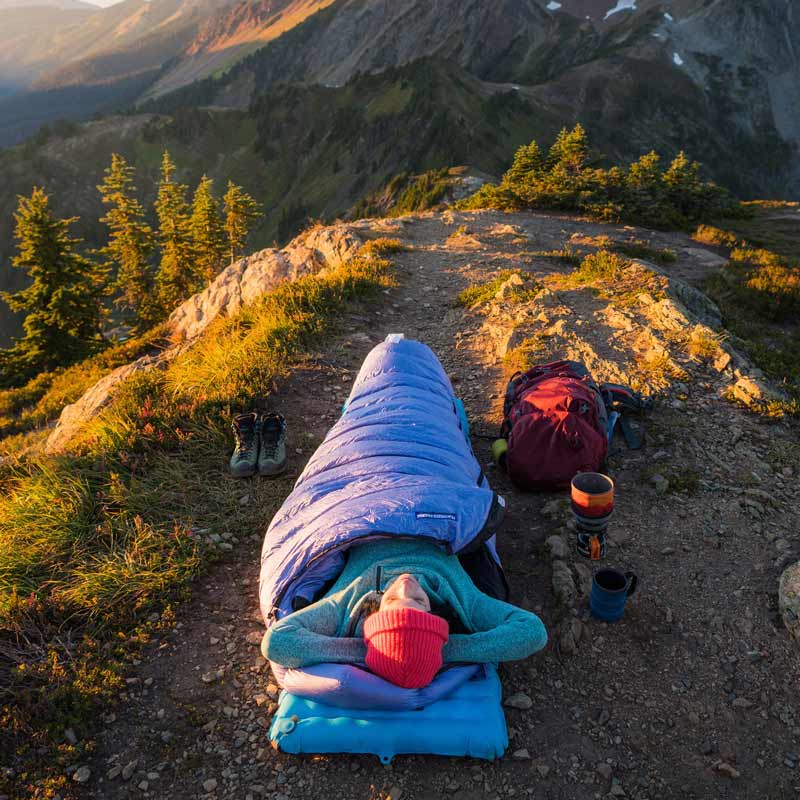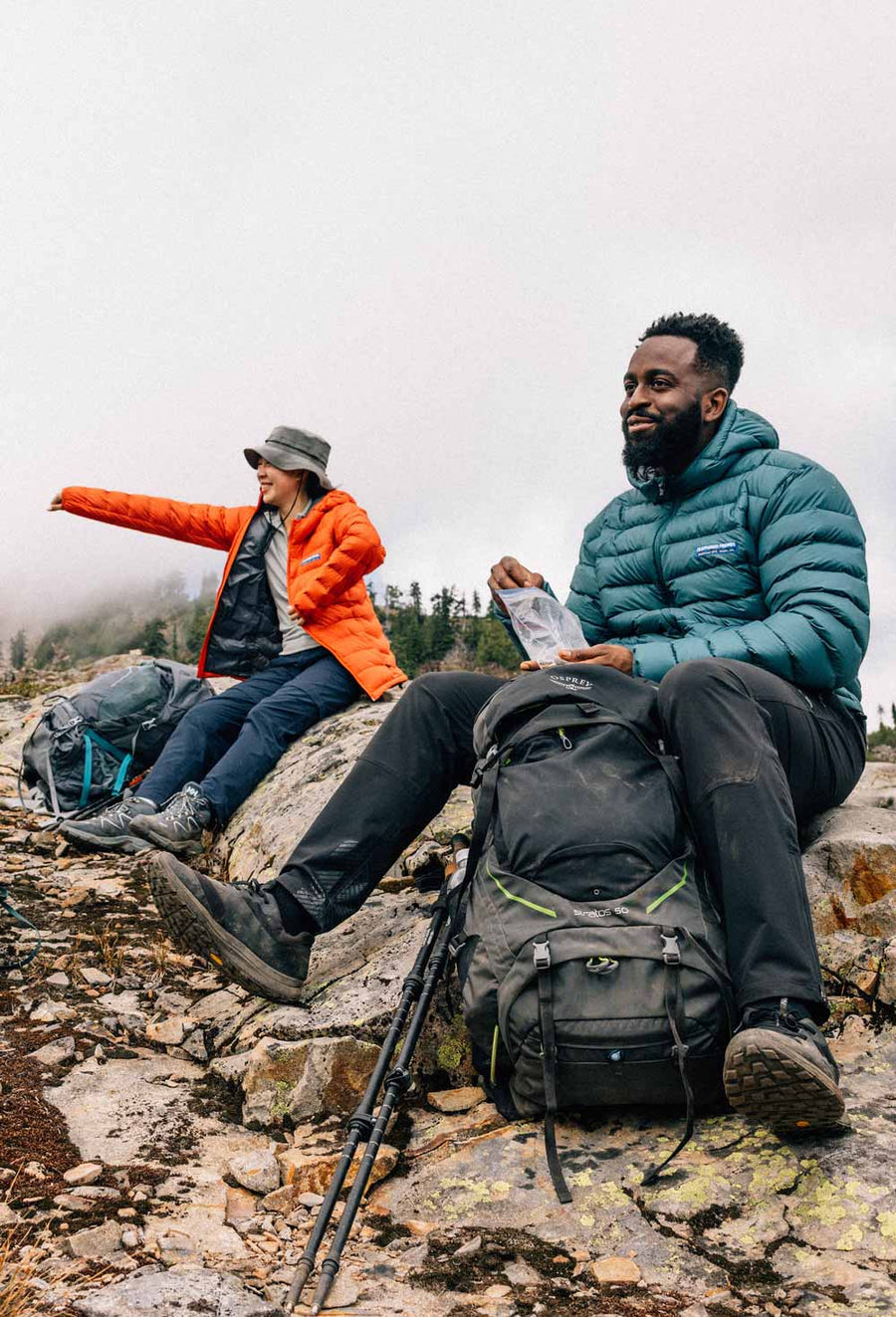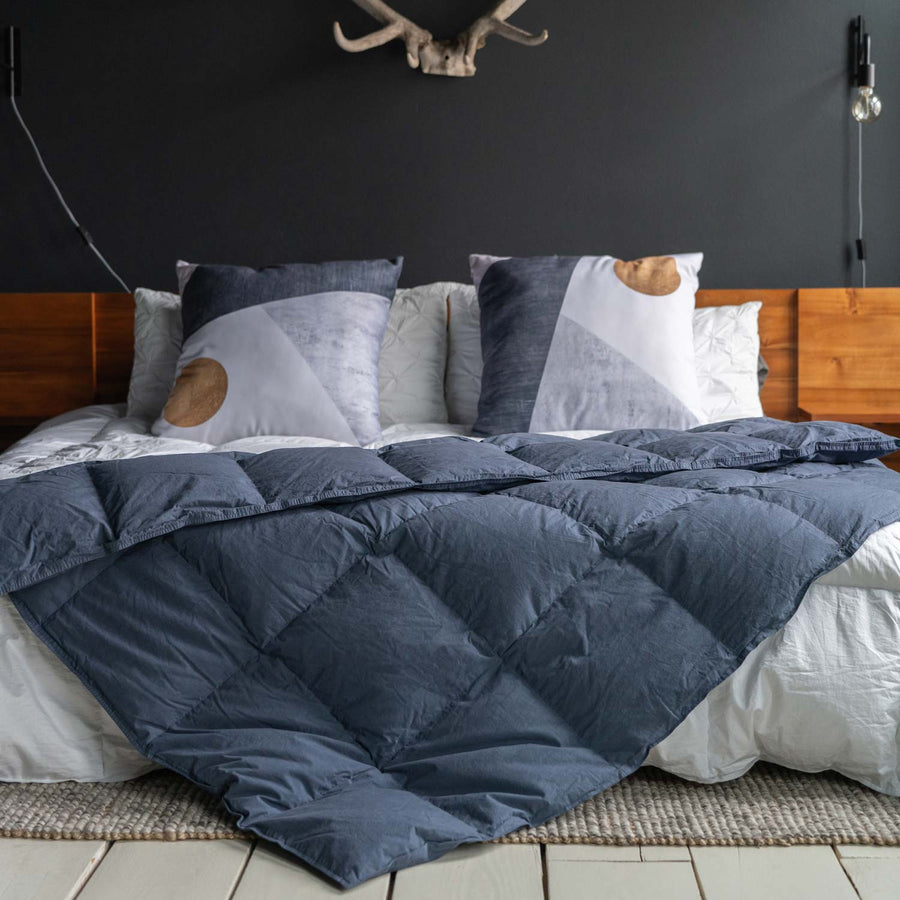Down Care Guide

Down is an absolutely amazing material, and with a little extra love your gear can be the gift that keeps on giving for a long time.
Below are the best practices to keep your favorite jacket, sleeping bag, or comforter fluffy and warm for years to come.
1. Storage
Just like us, our gear needs a good home when it is not out on an adventure. Down works so well in the outdoors because it is lightweight, warm, and compressible. We depend on our jacket or bag to squish into a pack and then re-loft as the temperatures drop in camp or on a climb. Down is happiest and will last the longest if it spends most of its time uncompressed, so all of our gear should be stored in a loose air-permeable bag or hung in a dry location.
- Jackets: Store on a hanger, ideally in a closet that is opened regularly for airflow.
- Bags: Store in a large sack made for long term storage, like the cotton sack that comes with all of our sleeping bags.
- Comforters and Pillows: When not on your bed, store in a large cotton sack.
Things to avoid:
- Do not leave your jacket or bag in a compression sack longer than you need to, as this reduces the loft of the down over time.
- Do not put your gear away wet or store it in a damp place; this is a recipe for mildew.
- If you have a furry companion who shares your sleeping space make sure their claws are trimmed and avoid having the pet sleep/ sit in the same spot.
A last note on comforters; the best thing you can do to keep your comforter clean is to put it inside a duvet cover that can be easily removed and washed.

2. Spot Cleaning
Sitting by the edge of a gorgeous alpine lake, you reach over for your breakfast and drop a big glop of oatmeal on your down jacket…it happens to the best of us, but luckily spot cleaning a small stain is easy. You probably already have the needed cleaners at home.
To clean small stains:
- Use a mild, non-detergent soap. Some dish soaps work well. Do not use bleach.
- Shake the down away from the spot you are treating. Using a clean cloth saturated with soap and water, gently rub the stain until it fades.
- Wipe the area with a clean damp cloth to remove the soap residue.
- Dry the item fully before storage.
Spot cleaning is also a great way to clean the cuffs and chin guard of a jacket, the places that often get dirtiest first.

3. Washing
How do you know your item needs to be washed? While this question depends a bit on personal preference (and tolerance for funky smells) there are a few general guidelines. Your item likely needs a wash if; it has large visible discolored/ dirty areas that can’t be addressed with a spot clean, something messy spilled on it, it smells bad enough that no one wants to share your tent or hike behind you, the edge of the comforter has yellowed from skin oils, or the item doesn’t loft as well as it used to.
If you use your gear on a regular basis, wash it! Contrary to some old beliefs, washing down properly won’t hurt it. It’s actually good for your gear to get a good sudsing every so often. Also, many of the technical fabrics we use employ coatings and laminates that can be damaged from extended exposure to body oils. We highly encourage you to learn the basics of washing down gear and to do so on a regular basis.
First and foremost: DO NOT DRY CLEAN ANY DOWN PRODUCTS. The chemicals used in dry cleaning damage the down, clog the pores of technical fabrics, and dry cleaning will void your Feathered Friends Warranty. If you use a cleaning service, be certain they are using cleaning methods appropriate for down.
Don’t be afraid to wash your down items yourself! It can be intimidating to put your beloved gear into a washing machine, but we have detailed directions on our website to walk you through it (Washing Down). Just remember to never use bleach, bleach-alternatives, or fabric softener, and also avoid a top loading wash machine with agitators as it will damage your garment or bag.
*When washing your items don’t be alarmed if the down congregates in certain areas; many of our items have long baffles (fabric channels) that the down is free to move around in. See section five for direction on how to redistribute the down fill.
If you’d rather leave it to the experts and don’t mind going without your favorite down gear for a bit, we can take care of it for you. We offer a cleaning service for Feathered Friends garments, bags, and bedding (with the exception of FeatherBeds). Sorry, we can only wash Feathered Friends items.
If you would like us to wash your items, print this form (link) and ship it with your item to the address listed on the form.

4. Refreshing Water Repellency
Remember the first time you had your jacket or bag outside in a light misty rain and the water beaded up and ran off? This happens because all of our technical fabrics are made with a special finish called DWR, or Durable Water Repellent. Over time, however, this finish can get tired and less effective. When water no longer beads up on the surface, it is time to replenish the DWR.
If the garment is new, simply washing it with a detergent made for technical fabrics and drying on medium heat for 30-45 minutes will re-activate the DWR finish. You MUST use a detergent that is designed for technical gear; normal detergents leave a residue on the fabric that attracts water.
For older garments, however, you may need to apply a spray on (avoid wash in) DWR replenishing treatment such as Grangers DWR, Nikwax TX.Direct Spray-On or ReviveX Spray-On Water Repellant. Follow the DWR manufacturers’ directions.
Lastly, please note that DWR is meant to shed low volumes of water; think a light rain as you are setting up camp or walking to the store, or water spilled from a bottle briefly over a sleeve. It is not a fully waterproof coating, and in sustained rain the fabric will become soaked and you will need to put on a rain shell. The exception to this are our expedition weight garments and bags made with Pertex® Shield®, which is a fully waterproof fabric that also has a DWR coating. Comforters do not have any water repellency, as they are made with materials optimized for the home instead of the outdoors.
5. Shifting the Down Fill
Some of our sleeping bags are constructed with continuous baffles (or fabric tubes) that hold the down and wrap completely around the bag. This design allows you to shift the down to the top or bottom of the bag – effectively raising or lowering its temperature rating – depending on the season, changing conditions, and your personal preference. For example, if you are using a sleeping pad with a high R value (reflected heat value) you can shift the down to the top of the bag, which allows it to loft fully and capture more warm air around you. Alternatively, in summer months you can shift some of the down to the bottom of the bag so you are less likely to overheat.
To shift the down, follow these steps (on a clean surface):
- Unzip the bag and lay flat.
- Hold the edge of the bag and give it a few firm shakes. The down will move away from you and concentrate on the side further from you.
- To return the bag to its regular configuration, reverse the process.
- Sometimes it might be necessary to use your hands to ‘pat’ the down from one place to another, especially in garments where the chambers are much smaller.
This method is also a great way to even out the down after a few trips, as the down fill will inevitably move from normal use.

6. Preventative Care
In addition to proper storage and cleaning practices, a few easy tips can help our gear stay in tip top shape over many seasons of use.
- Use care when walking or sitting near open flame. Like most modern garments, our shell fabrics will be damaged when in contact with flame. If you get a small hole from a spark, a dab of seam grip is a great way to seal it up.
- Down gear has to be washed more often when the fabric gets too saturated with oils from our skin. When it is cold enough to do so, wear clothing in your sleeping bag or unzip it to minimize sweat.
Pro tip: the sleeping bags are easily stuffed if you turn them inside out! - If you discover a hole in your down gear, cover the hole right away to prevent down loss, and then look into a more permanent repair after you return from your trip. A great solution is gear tape, which comes in many colors to match your garment or bag, and effectively seals small holes or snags. If you would like our factory to assess and repair your Feathered Friends product, please read the following form (link).
- Lightweight fabrics are great for shaving grams but they can also be prone to down ‘leaking’ through. If you see a feather or tendril poking through the fabric resist the urge to yank it out. If you do, it will frequently drag more down out with it, resulting in a larger hole. Instead, reach behind and pull the escapee back in. If you do develop a small hole in a nylon fabric, a warm iron can oftentimes seal it back up.
We are passionate about creating the best down products, and hope these tips and best practices help you enjoy your Feathered Friends gear for years to come.








Leave a comment